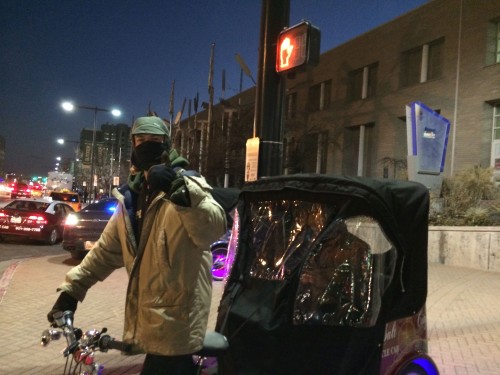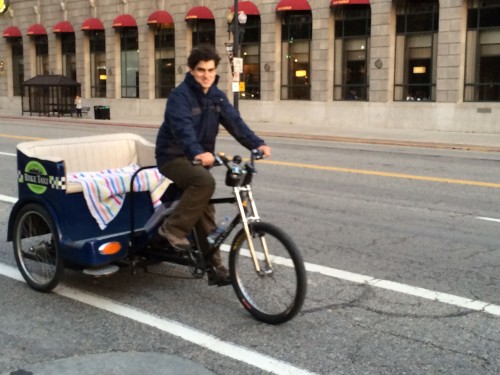
By Dave Iltis
June 15, 2015 – Salt Lake City is working on a new ordinance to regulate pedicabs – human or electric assisted bicycle taxis. The ordinance proposes to regulate how and where pedicabs can operate and who can drive them among many other areas. The rough draft ordinance is being circulated by the Salt Lake City licensing office and a copy was obtained by Cycling Utah. (Salt Lake City Draft Pedicab.Ordinance.Draft.2 )
According to Dan Bergenthal of the Salt Lake City Transportation Division, “The reason behind creating the draft ordinance was in response to the growing popularity of the industry.”
The ordinance is still in rough draft form and may still be modified before being sent to the Mayor’s office. It will also be run through the Bicycle Advisory Committee and the Transportation Advisory Board prior to being sent to the Salt Lake City Council, so there are many opportunities for comment. Pedicab companies have been asked to comment by June 19, 2015 on the draft.
The draft ordinance was generated from within Salt Lake City, according to Bergenthal, “We didn’t model our draft pedicab ordinance from any one city. Our draft is based on a review of several comparable cities as well as discussions with Business Licensing, the Attorney’s Office, Transportation Office and the Police Department. The draft has also been submitted to current pedicab business owners for their feedback.”

Salt Lake City currently has two main pedicab companies, Salt Lake Bike Taxi (http://slcbiketaxi.com/) and Salt City Cycle Cabs (http://saltcitycyclecab.com/). Salt Lake Bike Taxi has 8 pedicabs and is owned and operated by Jeff Bierce. Their pedicabs are mostly human powered with electric assist to get them going from a stopped position. Salt City Cycle Cabs is actually two separate LLC’s under one roof that have a total of five owners including Louis Gasper and 20 pedicabs. Their pedicabs have a greater amount of electric assist and allows them to obtain higher speeds.
The ordinance has a number of basic provisions that include how a driver is licensed, required background checks for licensees, requirements for the safe working condition of the pedicab, and insurance. It spells out that pedicabs must follow traffic laws, and may not be driven on the sidewalk. They must not be driven faster than 25 mph and must keep their lights on at similar times to motor vehicles.
The ordinance then goes in to a number of requirements that are potentially harmful to the pedicab business in general. Pedicabs would be barred from many downtown streets including State Street, parts of 700 E, much of 400 South, 500 South, and 600 South, a five block stretch of West Temple, and all of 300 West.
The reasoning behind this according to Dan Bergenthal is, “The thought is that because of their size and slow moving characteristics, it is desirable to minimize the use of pedicabs on the higher volume, higher speed roadways (major arterials) downtown. Please note that as currently drafted, the ordinance allows pedicabs to travel up to one block on the major arterials downtown “for the sole purpose of dropping a passenger off at a specific destination located on such block face”. He did not indicate that there have been any issues prompting the proposed ban.
Additionally, the Transportation Engineer (not defined as to who that person is) would be able to ban pedicabs on any arterial street that they “deem necessary.”
Salt City Cycle Cab’s Gasper expressed his displeasure with the ordinance and is worried it may put him out of business. Gasper noted,
“The Ordinance would essentially “box” our pedicab company within several main corridors of Salt Lake traffic. It would cut us off from close to 70% of our requested destinations. These locations are, but not limited to: Little America Hotel, Grand America Hotel, Green PIG, Jackelope, Harmons, Himalayans Kitchen, The Bayou, Bar Deluxe, The State Room, Sheraton, Motel 6, Red Lion HOTEL, Royal Garden INN, ENERGY SOLUTIONS ARENA’S ENTIRE EAST BORDER, Hyatt House, Cafe Trang, Vivace restaurant, State Liquor store, Bad Apple, City LIBRARY’s entire north quadrant, ETC. –Needless to say, removing State Street alone (not to mention the plethora of other roadways which are proposed to be pedicab-barred) from our accessible roadways would have enough negative financial repercussions to end our young business.
We service the hotel industry’s guests, and we make Salt Lake more accessible to conventioneers. This particular ordinance would bring most of this business to a screeching halt, affecting our business revenue greatly. We strive to obey all ordinances set forth by the city, and we wish to do so because we respect the municipality and we appreciate that we have a license to do business in Salt Lake. Unfortunately there has been a great overlooking of our actual business model and our common destination points with regard to the drafting of this ordinance. We like to stay off of very fast roads when judgment deems necessary, and we like to ride in bike lanes, however the fact is that we uphold our position to be treated like any other vehicle on the road, and the fact that we are a business should reinforce this, not detract from our endeavors. I have, as the owner of this company, invested tens of thousands of dollars to make our cabs fast enough to keep up with any 25-30 mph roadway’s flow of traffic. The city actually required me to have a 25MPH speed limit on my electric assist motorized pedicabs; as my cabs are capable of being programed to ride at speeds up to 35 mph. I agree to this limitation as I feel that that is plenty fast enough to get anywhere downtown in an expeditious fashion.
This ordinance would eliminate our ability to do business in very firmly established, routine areas that we are very experience and acclimated to servicing.”
The ordinance makes an accommodation that a pedicab may travel up to one block on the ‘banned’ streets in order to reach a needed destination “for the sole purpose of dropping a passenger off” on one of those ‘banned’ streets. The language would seem to preclude being able to pick up a passenger on one of these ‘banned’ streets.
Lastly, the ordinance would set out rules for fares for pedicab rides. These would generally require that fares be agreed upon in advance, and that if a driver specifies that a ride would be for a tip only, that they cannot then ask for a fare when the ride is over.
A key provision in the ordinance is the Violations section, which states that “Violation of any provision of this chapter shall be a class B misdemeanor.” From the State of Utah website, this would be punishable by up to 6 months in jail or up to a $1000 fine and puts pedicab violations in the same class as assault, shoplifting, trespassing, and public nuisance. https://www.utcourts.gov/howto/criminallaw/penalties.asp
This provision is typical of Salt Lake City Business code and could be changed, according to Bergenthal, “The reason for using the Class B misdemeanor classification for violations of the pedicab ordinance is that many similar chapters of the City’s business licensing ordinances likewise use a Class B misdemeanor as the default penalty used when regulating other businesses in the City. If the pedicab companies can provide some solid reasons as to why violations of the ordinance should be classified differently, then I think the City would be happy to listen and perhaps adjust the penalty classifications.”
Details on some of the provisions of the proposed ordinance
According to the proposed ordinance (see the attached pdf – click here), a pedicab would be defined as “A bicycle-type vehicle for the purpose of carrying passengers for hire that is propelled by human power or electric assisted, is not intended to exceed twenty-five (25) miles per hour and cannot exceed a combined voltage and amperage of 72v and a C-rate of 30 amps.”
The proposed ordinance includes licensing requirements for pedicab drivers, background checks and investigations – as well as an appeal process if a license is denied. Pedicab operators would be issued licenses that need to be renewed each year. The pedicab business would be required to train each driver on all aspects of what is in the ordinance. Additionally, there are a number of requirements for the pedicab operator to obtain a license. These include having to have a valid motor vehicle license, despite the fact that pedicabs are not motor vehicles. A license can be denied if a person is a registered sex offender, has a conviction in the last five years for reckless driving, has a conviction or release from confinement in the last five years “involving moral turpitude, narcotic or dangerous drugs, a felony conviction for an offense against a person or property.” And, lastly a person with two or more felonies or a driving under the influence conviction in the five years will be denied a license. If a person has rehabilitated themselves, they may appeal the denial decision, and a process is spelled out in the ordinance.
In regards to the pedicab itself, the ordinance spells out some seemingly reasonable requirements including working brakes, functioning brake lights and headlight, seatbelts, and must be kept clean and sanitary.
Pedicabs would be required to be insured with policy limits of $1 million per incident and $2 million aggregate.
It remains to be seen whether the ordinance will be sent to the Salt Lake City Council as is, or with major changes.
The ordinance is anti-bicycling, Gasper feels,
“This ordinance would put a company of nearly 50 dedicated cyclists out of a business. It would have negative repercussions in the cycling industry therefore, and this is not a small matter in the eyes of myself or my career riders. In a city which aches for a cleaner environment, pedicabs offer a solution which can be seen and felt on financial as well as sociological levels. We have the magic of cycling intertwined into our business, and people feel this. They notice it. The cycling community gets excited and smiles come to their faces when they see us. This is a very anti-bicycling proposal for an ordinance; one which lacks any shred of investigative and mitigated decision making.”
To comment on the proposed ordinance, please send email to:

Analysis
With the increased popularity of pedicabs as a form of for-hire transportation in the downtown area, and one that fills a gap for short rides that taxis and ride-sharing services like UBER and Lyft may not want to service, regulation of pedicabs is necessary. Pedicabs are environmentally responsible and bicycle friendly transportation and a key part of a bike friendly Salt Lake City and Utah. An ordinance ensures a consistent and safe experience for customers, drivers, and companies. It also ensures fair and upfront pricing, which is key to a good customer experience.
As a pedicab driver many years ago in Hawaii, I saw first hand the benefit pedicabs had for tourists wanting to get around Waikiki for both transportation and sight-seeing. Pedicabs at that time were well regulated and other than over-zealous police officers, they encountered few problems.
Unlike Salt Lake City’s ordinance, pedicabs were not banned from any streets. They naturally stayed away from some of the more high speed roads, and gravitated where there were more tourists and business – similar to Salt Lake City.
Many provisions of the ordinance are reasonable and necessary. Drivers should be licensed, pedicabs should be in good working order, have lights, brakes, and be kept clean. Safety for the passenger is a priority in the ordinance, and that is a good thing.
In its current form, the ordinance is huge step backwards for Salt Lake City’s bike friendliness. Banning bikes (pedicabs are bicycles) on various city streets sets a dreadful precedent and is very car centric.
The goal should not be to ban pedicabs on the various arterials in the downtown area, but rather to make all of these arterials safe for bicycles and hence for pedicabs. Additionally, the ban would hurt the pedicab business. Salt Lake City should be encouraging non-polluting transportation rather than hindering it.
I would recommend removing the proposed ban section entirely.
The class B misdemeanor section for penalties is too harsh. A driver, for example, should be given just a traffic citation for things like having a tail light out, riding on the sidewalk, or riding on a banned road (if that section remains in the ordinance).
The draft ordinance states that drivers need to renew their licenses every year. This is too frequent, especially given that the ground transportation code only requires licensees to renew ride-sharing licenses every 2 years.
Another change that needs to be made is to allow pedicab drivers to leave their pedicab parked on the street if they need to go eat or use the facilities. The draft ordinance requires that drivers not leave the pedicab.
All in all, the ordinance would be vastly improved if the ban on riding on certain downtown city streets were removed, and various other smaller clauses were changed. In its current form, it is not workable.


[…] Utah last reported on the ordinance in June of 2015 (see: https://www.cyclingwest.com/advocacy/salt-lake-city-prepares-to-regulate-pedicabs/ ). There were a number of problems with the ordinance, including the possible ban of pedicabs on […]